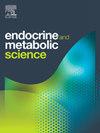Acromegaly: Is earlier diagnosis possible? Exploration of a screening algorithm to select high-risk patients
Q3 Medicine
引用次数: 0
Abstract
Purpose
Given the ongoing need to reduce the delay in diagnosis of acromegaly, the aim of the current study was to develop a screening algorithm that: finds as many patients as possible who have already been diagnosed with acromegaly (=sensitivity), while identifying a limited number of additional patients who are at risk for acromegaly as a proxy for specificity.
Methods
CTcue data mining software (version 4.7, IQVIA Inc., USA) was used to develop a screening algorithm. Data were extracted from the electronic health records of a tertiary centre. Multiple sources (literature review, real-world evidence and expert opinion) were used to identify predictors such as clinical manifestations, comorbidities and frequently consulted specialists, for inclusion in the algorithm. Based on different combinations of predictors, several exploratory search strategies were constructed in CTcue and algorithms with the highest sensitivity were further adapted.
Results
A total of 68 predictors were identified and grouped into 5 categories. After exploratory analysis and fine-tuning, an algorithm combining pathognomonic changes in clinical appearance with manifestations considered by medical experts to be most characteristic of acromegaly (hyperhidrosis, sleep apnoea, arthralgia, headache and type 2 diabetes mellitus) detected 48/90 of patients with previously diagnosed acromegaly, while identifying an additional 1844/1,7 million of possible at-risk patients.
Conclusion
We found that our best algorithm led to the detection of more than half of patients with previously diagnosed acromegaly. The same algorithm identified 0.1 % of the hospital population as potentially having acromegaly, which is approximately 10 times higher than the estimated worldwide prevalence. These results seem promising but need further improvement and validation.
肢端肥大症:早期诊断可能吗?探索一种筛选高危患者的筛选算法
鉴于持续需要减少肢端肥大症的诊断延迟,本研究的目的是开发一种筛选算法:发现尽可能多的已经诊断为肢端肥大症的患者(=敏感性),同时识别有限数量的额外有肢端肥大症风险的患者作为特异性的代理。方法采用sctcue数据挖掘软件(美国IQVIA Inc. 4.7版)开发筛选算法。数据取自一家三级医疗中心的电子健康记录。多种来源(文献综述、真实世界证据和专家意见)用于确定临床表现、合并症和经常咨询专家等预测因素,以便纳入算法。基于不同的预测因子组合,在CTcue中构建了几种探索性搜索策略,并进一步调整了灵敏度最高的算法。结果共识别出68个预测因子,并将其分为5类。经过探索性分析和微调,将临床表现的病理变化与医学专家认为最具肢端肥大症特征的表现(多汗症、睡眠呼吸暂停、关节痛、头痛和2型糖尿病)相结合的算法检测出48/90先前诊断的肢端肥大症患者,同时识别出另外1844/ 170万可能的高危患者。结论我们发现,我们的最佳算法可以检测出超过一半的先前诊断为肢端肥大症的患者。同样的算法确定0.1%的医院人口可能患有肢端肥大症,这比估计的全球患病率高出约10倍。这些结果似乎很有希望,但需要进一步改进和验证。
本文章由计算机程序翻译,如有差异,请以英文原文为准。
求助全文
约1分钟内获得全文
求助全文
来源期刊

Endocrine and Metabolic Science
Medicine-Endocrinology, Diabetes and Metabolism
CiteScore
2.80
自引率
0.00%
发文量
4
审稿时长
84 days
 求助内容:
求助内容: 应助结果提醒方式:
应助结果提醒方式:


